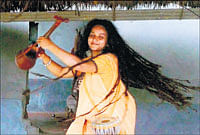
At the age of 16, she had become one of the few female singers to have been initiated into the Baul tradition.
One could earlier identify her by her dreadlocks which reach up to her knees, the saffron sari she would wear, and the garland made of tulsi seeds around her neck.
However, nowadays, she is forced to wear a white and red sari because people keep asking her to give blessings for a better future while she is someone who is only concerned about ‘here and now’.
Baul music draws inspiration from Chorja Giti, a 7th century text written in old Bengali in the format of a Baul song.
“The word Baul comes from Batul, which refers to someone who is drunk on love, which can be pure love or bhakti. They speak the words of love that come from experience and sing of the divine madness,” says Parvathy, speaking about the origin of Baul traditions.
“There is no evidence of where it originated because the tradition has travelled. The important thing is that they are all from the same truth but take the form of different languages and styles,” she adds.
There is a common perception that Baul singers go into a trance while performing because it looks like that to someone who does not understand the intricacies of the music. But Parvathy corrects this misconception.
“We are in complete control of ourselves and know exactly what we’re doing. One just becomes very connected with oneself. The ego disappears and it just becomes very light,” she says, explaining what goes on within a Baul singer.
“Bhel puri and pani puri are the only things that can put me in a trance. I can’t control myself when I see them,” she jokes. Traditionally, Bauls are supposed to perform alone, but nowadays, they tend to perform and travel in groups. Parvathy, however, has always been a solo performer and she not only whirls and sings but even plays the iktara and the duggi, a small Indian drum, at the same time.
A little known fact that she shares is that her iktara was made and designed by her husband-turned-guru, Ravi Gopalan Nair. One might be curious about what exactly the Baul songs are about and only a true Baul holds the answer to that.
“The songs are either about gyaan bhakti or raga anuga bhakti. Gyaan bhakti is from clear knowledge — from the words of masters or the Vedas. It is when you realise that from true knowledge comes great surrender. Raga anuga bhakti is from surrender to the unknown — there is passion without knowing or understanding the bhakti,” explains the smiling Parvathy, before she proceeds to sing Pare loye jao amay, her favourite Baul song of all times that was composed by Lalan Fakir.